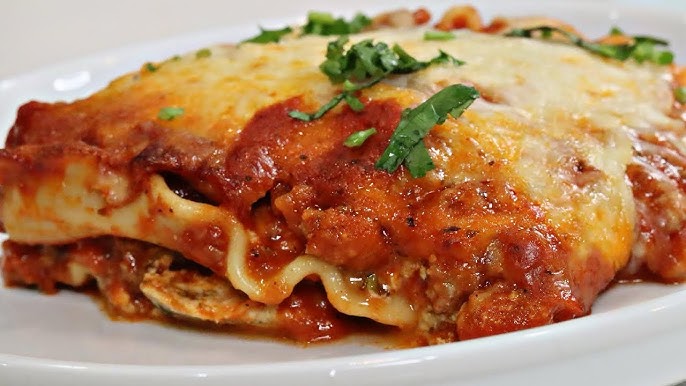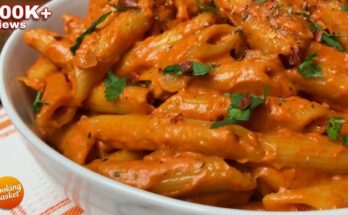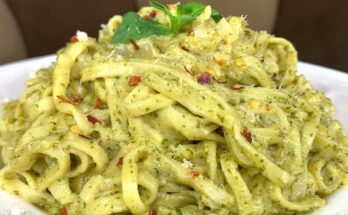Turkey Lasagna Recipe: There’s nothing quite like a hearty, warm lasagna fresh out of the oven. But if you’re looking for a lighter, healthier spin on this classic comfort food, turkey lasagna is your answer. Swapping out beef for lean ground turkey cuts back on fat without sacrificing that rich, savory flavor you crave in every bite. It’s the kind of meal that hits the spot and doesn’t weigh you down afterward.
Turkey lasagna isn’t just about being healthy—it’s also versatile and easy to personalize. You can load it with extra veggies, switch up the cheese, or even go gluten-free with your noodle choice. Whether you’re cooking for a crowd, prepping meals for the week, or hosting a family dinner, this recipe is the perfect go-to.
In this guide, we’ll walk you through everything from the ingredients to the layering technique, and all the tips to make your turkey lasagna taste like it’s straight from an Italian kitchen. Ready to dive into deliciousness? Let’s get cooking!
Ingredients You’ll Need
Getting your ingredients right is the first step to making an unforgettable turkey lasagna. Here’s a breakdown of what you’ll need for each layer of this masterpiece.
For the Turkey Sauce
This meaty tomato sauce brings the heartiness to your lasagna without being too greasy or heavy.
- 1 lb (450g) lean ground turkey
- 1 small onion, finely chopped
- 3 cloves garlic, minced
- 1 (28 oz) can crushed tomatoes
- 1 (6 oz) can tomato paste
- 1 tsp dried oregano
- 1 tsp dried basil
- ½ tsp chili flakes (optional for heat)
- Salt and pepper to taste
- 1 tbsp olive oil
The turkey sauce is rich in protein and gives the dish that traditional meaty texture, with a healthier twist.
For the Cheese Mixture
The cheese filling is where all the creaminess comes in. This trio of cheeses creates that stretchy, gooey layer everyone loves.
- 1 ½ cups ricotta cheese
- 2 cups shredded mozzarella cheese
- ½ cup grated Parmesan cheese
- 1 egg
- 1 tsp garlic powder
- ½ tsp black pepper
- 2 tbsp chopped fresh parsley (or 1 tsp dried)
Mixing the cheeses with egg binds everything together and keeps the filling creamy without becoming too runny during baking.
For the Lasagna Layers
The noodles and oil help bind the entire dish together, keeping things structured and flavorful.
- 9 lasagna noodles (regular or oven-ready)
- Salt for boiling water
- 1 tbsp olive oil (for boiling noodles or greasing pan)
- Additional 1 cup shredded mozzarella for topping
Depending on your preferences, you can go with whole wheat or gluten-free noodles as alternatives.
Essential Tools You’ll Need
Before diving into the cooking process, let’s make sure your kitchen is prepped and ready. Having the right tools can make or break your lasagna-making experience.
Kitchen Utensils
- Large Skillet – For browning the turkey and simmering the sauce.
- Mixing Bowls – To combine cheese fillings and other ingredients.
- Baking Dish (9×13 inch) – The classic lasagna pan size.
- Spatula or Wooden Spoon – Ideal for stirring sauce and layering.
- Measuring Cups and Spoons – For precision and balance in flavors.
These basic tools are essential and usually already in your kitchen, so you’re likely good to go.
Optional but Helpful Tools
- Food Processor – For chopping onions or grating cheese faster.
- Cheese Grater – Freshly grated cheese melts better and tastes richer.
- Aluminum Foil – For covering the lasagna during the first half of baking to prevent the cheese from burning.
Having these on hand can speed things up and make your cooking experience a lot smoother.
Step-by-Step Guide to Making Turkey Lasagna
Ready to bring it all together? Let’s break it down into a foolproof, step-by-step guide.
Step 1 – Prepare the Turkey Sauce
Heat oil in a large skillet over medium heat. Add ground turkey and cook until browned. Stir in onions, garlic, tomato sauce, diced tomatoes, and Italian seasoning. Add salt, pepper, and a pinch of red pepper flakes for depth. Let it simmer for 15–20 minutes until thick and flavorful.
Step 2 – Mix the Cheese Filling
In a bowl, combine ricotta cheese, mozzarella, Parmesan, 1 beaten egg, and chopped parsley or basil. Mix well until creamy.
Step 3 – Cook the Lasagna Noodles
Boil noodles in salted water until al dente, then drain and lay flat to prevent sticking.
Step 4 – Assemble the Lasagna
Layer sauce, noodles, cheese mixture, and repeat. End with sauce and shredded mozzarella on top.
Step 5 – Bake the Lasagna
Bake at 375°F (190°C) for 35–40 minutes, covered with foil. Uncover for the last 10 minutes until bubbly and golden. Let it rest 10 minutes before slicing—pure comfort food perfection.
Pro Tips for the Best Turkey Lasagna
Making turkey lasagna isn’t just about following a recipe—it’s about mastering the little things that take it from good to incredible.
Choosing the Right Turkey
All ground turkey isn’t created equal. Here’s what to look for:
- Lean Ground Turkey (93/7) – Best balance of flavor and health.
- Ground Turkey Breast – Even leaner, but may be a bit dry. Add extra olive oil or veggies for moisture.
- Avoid Pre-Seasoned Turkey – It may contain additives and excess salt.
Freshly ground turkey from a butcher is often higher quality than prepackaged meat. Always check the expiration date and color—it should be light pink, not gray.
Avoiding a Watery Lasagna
One of the biggest complaints people have with lasagna is when it turns out too wet. Here’s how to avoid it:
- Simmer the Sauce Longer – Reduce moisture in the tomato base.
- Drain the Noodles Well – Excess water can seep into your layers.
- Let it Rest – Always rest your lasagna post-baking. It sets up better and cuts cleaner.
Also, don’t overload the ricotta layer—it can release water if overused or not well-mixed with egg.
Make-Ahead and Freezing Tips
Turkey lasagna is ideal for meal prep. You can make it ahead, freeze it, and bake when needed:
- Make-Ahead: Assemble the lasagna and refrigerate up to 24 hours before baking.
- Freeze: Wrap tightly in plastic wrap and foil. Label with date.
- Bake from Frozen: Add 20-30 extra minutes to the baking time, keeping it covered.
You can also bake it first, then freeze individual portions for quick weekday meals.
Common Mistakes to Avoid
Even the most experienced home cooks can make simple errors that affect the final outcome of their turkey lasagna. Here are some of the most common mistakes and how to avoid them for a flawless dish every time.
Overcooking the Noodles
Lasagna noodles are the backbone of your dish—overcook them, and you’ll end up with mush. Here’s how to get it right:
- Cook until al dente (slightly firm), not soft.
- If using oven-ready noodles, ensure your sauce has enough liquid to soften them during baking.
- After boiling, cool noodles quickly under cold water to stop the cooking process.
Soggy noodles can ruin the texture of your lasagna, so keep a close eye on them while boiling.
Using Too Much Sauce
While a juicy, flavorful sauce is key, drowning your lasagna in it can make the dish watery and unbalanced.
- Use just enough sauce to coat each layer without saturating it.
- Let the sauce reduce while simmering to remove excess moisture.
- Drain any excess liquid from veggies (like spinach or mushrooms) if you add them to the sauce.
Balance is everything. You want your lasagna to hold its shape, not fall apart into a soup.
Uneven Layering
Messy layering results in uneven cooking and taste. For the best results:
- Use a consistent portion of each layer—about the same amount of cheese, sauce, and noodles.
- Use a spatula or spoon to spread fillings evenly across the surface.
- Press each layer down gently to remove air pockets.
Neat layers not only help your lasagna bake evenly but also look great when served.
Serving Suggestions
Turkey lasagna is hearty enough to stand on its own, but pairing it with the right sides can turn it into a full-course Italian feast. Here are some top picks:
Perfect Side Dishes
- Garlic Bread – The ultimate companion to mop up that leftover sauce.
- Caesar Salad – Crisp romaine, creamy dressing, and Parmesan are a refreshing contrast.
- Steamed Veggies – Broccoli, green beans, or roasted carrots add a healthy balance.
- Caprese Salad – Tomato, basil, and mozzarella bring a fresh, summery vibe.
Add a side of marinated olives or antipasto if you’re entertaining guests. It sets the mood and complements the Mediterranean flavors beautifully.
Wine and Drink Pairings
If you’re enjoying a cozy dinner, wine can elevate the entire experience.
- Red Wine: Try a medium-bodied red like Chianti, Zinfandel, or Merlot.
- White Wine: A Chardonnay with some oakiness pairs surprisingly well.
- Non-Alcoholic: Sparkling water with lemon or iced tea with mint also work great.
Choose a drink that complements the richness of the lasagna but doesn’t overpower the dish.
Storing and Reheating Leftovers
Lasagna is one of those magical dishes that often tastes even better the next day. Here’s how to store and reheat it while keeping all the goodness intact.
Proper Storage
- Refrigerate: Store leftovers in an airtight container or tightly covered baking dish.
- Shelf Life: It stays good in the fridge for 3 to 5 days.
- Freeze: For longer storage, portion the lasagna into slices, wrap in plastic and foil, and freeze for up to 3 months.
Use labels with dates if you’re storing in bulk—it makes meal planning a breeze.
Reheating Tips
- Microwave: Cover with a damp paper towel to prevent drying. Heat for 2-3 minutes.
- Oven: Preheat to 350°F (175°C), cover lasagna with foil, and bake for 20-25 minutes.
- From Frozen: Thaw overnight in the fridge or bake directly from frozen at 375°F (190°C) for 45-60 minutes, covered.
Always check that the internal temperature reaches at least 165°F (74°C) before serving.
Nutritional Information (Per Serving)
Want to know exactly what you’re putting into your body? Here’s an estimate based on standard ingredient portions and a recipe that serves eight:
| Nutrient | Amount Per Serving |
|---|---|
| Calories | 410 kcal |
| Protein | 35g |
| Carbohydrates | 28g |
| Total Fat | 18g |
| Saturated Fat | 8g |
| Fiber | 3g |
| Sugars | 7g |
| Sodium | 720mg |
| Cholesterol | 85mg |
Keep in mind these values can vary depending on the specific brands of ingredients and your customizations.
FAQs about Turkey Lasagna Recipe
Can I use ground chicken instead of turkey?
Absolutely! Ground chicken works as a great substitute with a similar texture and flavor profile. Just be sure to use the same seasonings and cooking method.
How long does turkey lasagna last in the fridge?
Properly stored in an airtight container, turkey lasagna will last 3 to 5 days in the fridge. Always reheat to an internal temperature of 165°F (74°C).
Can I make it dairy-free?
Yes! Use dairy-free ricotta and mozzarella alternatives, and skip the Parmesan or find a vegan version. Plant-based cheeses melt well and still deliver that creamy texture.
What’s the best way to freeze lasagna?
Wrap tightly in both plastic wrap and aluminum foil to prevent freezer burn. Label with the date, and freeze for up to 3 months. Thaw in the fridge overnight before baking or bake straight from frozen with extra time.
Can I use no-boil noodles instead?
Yes, oven-ready noodles are a convenient option. Just ensure your sauce is slightly more liquidy so it softens the noodles properly during baking.
Conclusion
Making turkey lasagna from scratch might seem like a big task, but it’s incredibly rewarding. From the rich, hearty turkey sauce to the creamy, cheesy layers and perfectly cooked noodles, every element contributes to a dish that’s comforting, delicious, and lighter than the traditional version.
It’s a meal that brings people together—whether it’s a casual weekday dinner or a celebratory feast. With the step-by-step guide, pro tips, and storage suggestions you’ve got here, you’re now more than ready to master the art of turkey lasagna. Don’t be afraid to put your own spin on it—add veggies, spice it up, or make it gluten-free. The kitchen is your playground.
Now get in there and start layering. Your perfect turkey lasagna awaits!



